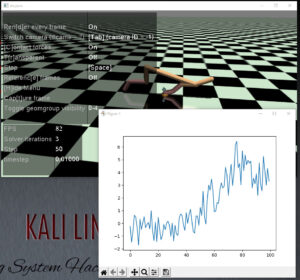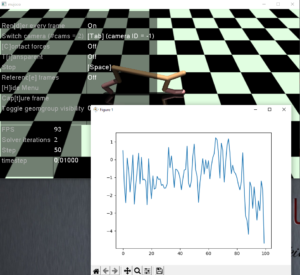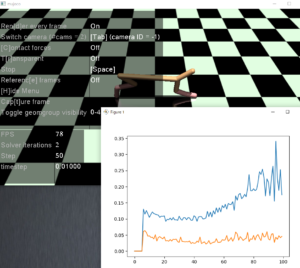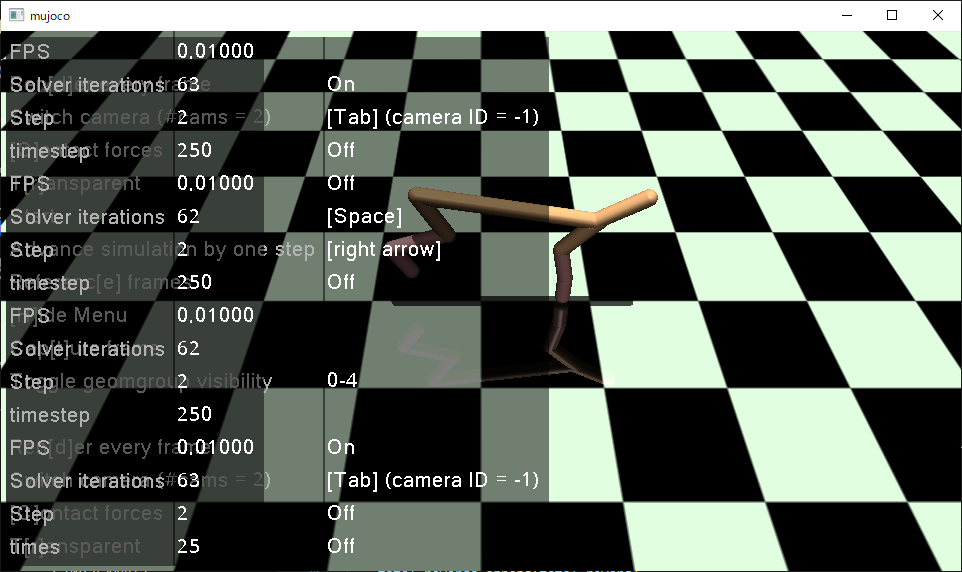さて、日をあけてしまいましたが、続きをやっていきましょう。
Contents
前回
actorが行動して集めたデータから、経験再生を使って「次の状態」からtarget_actorが「次の行動」を出力し、「次の行動」と「次の状態」からtarget_criticが「次の状態価値」出力し、TDターゲットを算出しました。
一方で、criticは経験再生を使って「現在の状態」と「そのとき取った行動」から「現在の状態価値」別名ベースラインを算出しました。
今回
ここからは、本当の意味で学習・訓練、つまりパラメータ更新をやっていきます。
オプティマイザーを定義する
オプティマイザーをActorNNクラスとCriticNNクラスの__init__()に定義しておきます。
【ActorNN】#26
self.optimizer = optim.Adam(self.parameters(), lr=alpha)
【CriticNN】#27
self.optimizer = optim.Adam(self.parameters(), lr=beta)
引数のself.parameters()は、モデル自身が持っている重みやバイアスのパラメータです。それを学習率lrでAdamによって最適化(損失関数の最小化)するインスタンスself.optimizerを定義します。
criticの学習
lean()メソド内でのTDターゲット算出後からやっていきます。
|
1 2 3 4 5 6 7 8 9 10 11 12 13 |
# ==== (1)クリティックの学習 ==== # 28.クリティックの勾配をゼロに初期化する self.critic.optimizer.zero_grad() # 29. TDターゲットと状態価値の二乗誤差を算出して、クリティックの損失関数とする。バッチサイズは64個 critic_loss = F.mse_loss(td_targets, critic_values) # 30. クリティックの損失関数を微分して、勾配を算出する critic_loss.backward() # 31. 勾配からオプティマイザーによってクリティックのパラメータ(重みとバイアス)を更新する self.critic.optimizer.step() |
actorの学習
続けてactorを学習します。
Actorの目的は、Criticネットワークの出力(行動価値)を最大化するような行動を選択することです。
なので、actorNN→criticNNのDDPG構造全体の出力結果をactor_lossとして、actorNNとcriticNNの両方をbackwardすることによってactorにも勾配情報が届きパラメータの更新をすることができます。
|
1 2 3 4 5 6 7 8 9 10 11 12 13 14 15 16 17 18 19 20 21 22 23 |
# ==== (2)アクターの学習 ==== # 32. アクターの勾配をゼロに初期化する self.actor.optimizer.zero_grad() # 33. アクターに観測情報を入力して行動を算出する。バッチサイズは64個 predicted_actions = self.actor.forward(observations) #self.actor.train() # 34.アクターの損失関数を算出する # Actorの目的は、Criticネットワークの出力(行動価値)を最大化するような行動を選択すること。 # なので、actorNN→criticNNのDDPG構造全体の出力結果をactor_lossとして、actorNNとcriticNNの両方をbackwardし、 # actorだけをパラメータ更新することによりactorの学習をすることができる。 actor_loss = -self.critic.forward(observations, predicted_actions) actor_loss = T.mean(actor_loss) # 35. DDPG構造全体の損失関数actor_lossを微分し、勾配を算出する actor_loss.backward() # 36. 勾配からオプティマイザーによってアクターのパラメータだけを(重みとバイアス)を更新する self.actor.optimizer.step() |
全ニューラルネットワークのパラメータを更新する
learn()メソドの締めくくりとして、36の直後にself.update_network_parameters()を入れ、メソドとして定義します。
|
1 2 3 4 5 6 7 8 9 10 11 12 13 14 15 16 17 18 19 20 21 22 23 24 25 26 27 28 29 30 31 32 33 34 35 36 37 38 39 40 41 42 |
# 37. パラメータ更新メソド。 def update_network_parameters(self, tau=None): if tau is None: tau = self.tau # 38. actor, critic, target_actor, target_criticのネットワーク内の全てのパラメータ(重みとバイアス)とその名前を取得する # actorとcriticは先ほど更新されたばかりのパラメーター actor_params = self.actor.named_parameters() critic_params = self.critic.named_parameters() target_actor_params = self.target_actor.named_parameters() target_critic_params = self.target_critic.named_parameters() print('actor_params : ', actor_params) # actor_params : <generator object Module.named_parameters at 0x000001661B2D9D48> # 39. パラメータをディクショナリとして取り出す。 actor_params_dict = dict(actor_params) critic_params_dict = dict(critic_params) target_actor_params_dict = dict(target_actor_params) target_critic_params_dict = dict(target_critic_params) print('actor_params_dict : ', actor_params_dict) print(actor_params_dict.keys()) """ actor_params_dict : {'fc1.weight': Parameter containing: tensor([[-0.1895, -0.0343, 0.1138, ..., 0.2157, 0.0527, -0.1173],/ dict_keys(['fc1.weight', 'fc1.bias', 'fc2.weight', 'fc2.bias', 'fc3.weight', 'fc3.bias']) """ # 40. クリティックの各パラメーター毎に 更新重みtau=0.0001の分だけほんの少しcriticパラメータをtarget_criticパラメータに近づける。 for name in critic_params_dict: critic_params_dict[name] = tau * critic_params_dict[name].clone() + \ (1-tau) * target_critic_params_dict[name].clone() # 41. 更新したcriticパラメータをtarget_criticのパラメータとしてロードする。 self.target_critic.load_state_dict(critic_params_dict) # 42.アクターの各パラメーター毎に 更新重みtau=0.0001の分だけほんの少しactorパラメータをtarget_actorパラメータに近づける。 for name in actor_params_dict: actor_params_dict[name] = tau * actor_params_dict[name].clone() + \ (1 - tau) * target_actor_params_dict[name].clone() # 43. 更新したactorパラメータをtarget_actorのパラメータとしてロードする。 self.target_actor.load_state_dict(actor_params_dict) |
学習結果の確認
クリティックとアクタークリティックのパラメータ更新まで行ってアクターとターゲットアクターのパラメーター更新をしない状態で試してみました。
動作確認のつもりでやりましたが、学習は進んでいるようです。

10step x 100epsode で学習したところ、ハーフチーターはエピソード開始直後に前へ倒れこむような挙動を獲得し、リワードを稼ぐようになりました。10stepでは走り続ける動作を獲得するのは無理なようです。
続いて、アクターとターゲットアクターのパラメーター更新も追加して同じことを行いました。

こちらは、足を折りたたんで低い姿勢なることでリワードを稼ぎに行っているようです。しかし80エピソードから成績が悪化していっています。うまく学習が進んでいないようです。
まあ、ニューラルネットワーク構造もまだ適当に作っているので、改善の余地があります。
また下記のようにactor_lossesとcritic_lossesの変化も可視化してみると下記のように悪化していく方向にあります。

課題
- 計算の高速化(print文の無効化)
- 適切なニューラルネットワーク構造
- 適切なステップ数
- 適切なエピソード数
- パラメータのセーブとロード
- 途中で止まった時に続行可能にしたい
- 計算の高速化(GPUの利用)
- 学習の進行状況のリアルタイム可視化
現在までのスクリプト
|
1 2 3 4 5 6 7 8 9 10 11 12 13 14 15 16 17 18 19 20 21 22 23 24 25 26 27 28 29 30 31 32 33 34 35 36 37 38 39 40 41 42 43 44 45 46 47 48 49 50 51 52 53 54 55 56 57 58 59 60 61 62 63 64 65 66 67 68 69 70 71 72 73 74 75 76 77 78 79 80 81 82 83 84 85 86 87 88 89 90 91 92 93 94 95 96 97 98 99 100 101 102 103 104 105 106 107 108 109 110 111 112 113 114 115 116 117 118 119 120 121 122 123 124 125 126 127 128 129 130 131 132 133 134 135 136 137 138 139 140 141 142 143 144 145 146 147 148 149 150 151 152 153 154 155 156 157 158 159 160 161 162 163 164 165 166 167 168 169 170 171 172 173 174 175 176 177 178 179 180 181 182 183 184 185 186 187 188 189 190 191 192 193 194 195 196 197 198 199 200 201 202 203 204 205 206 207 208 209 210 211 212 213 214 215 216 217 218 219 220 221 222 223 224 225 226 227 228 229 230 231 232 233 234 235 236 237 238 239 240 241 242 243 244 245 246 247 248 249 250 251 252 253 254 255 256 257 258 259 260 261 262 263 264 265 266 267 268 269 270 271 272 273 274 275 276 277 278 279 280 281 282 283 284 285 286 287 288 289 290 291 292 293 294 295 296 297 298 299 300 301 302 303 304 305 306 307 308 309 310 311 312 313 314 315 316 317 318 319 320 321 322 323 324 325 326 327 328 329 330 331 332 333 334 335 336 337 338 339 340 341 342 343 344 345 346 347 348 349 350 351 352 353 354 355 356 357 358 359 360 361 362 363 364 365 366 367 368 369 370 371 372 373 374 375 376 377 378 379 380 381 382 383 384 385 386 387 388 389 390 391 392 393 394 395 396 397 398 399 400 401 402 403 404 405 406 407 408 409 410 411 412 413 414 415 416 417 418 419 420 421 422 423 424 |
import gymnasium as gym import time import torch as T import torch.nn as nn import torch.nn.functional as F import torch.optim as optim import numpy as np import matplotlib.pyplot as plt # 10. ReplayBufferクラスを新規作成する class ReplayBuffer: def __init__(self, max_memory_size, n_obs_space, n_action_space): self.max_memory_size = max_memory_size self.n_obs_space = n_obs_space self.n_action_space = n_action_space self.memory_count = 0 self.state_memory = np.zeros((self.max_memory_size, self.n_obs_space)) self.action_memory = np.zeros((self.max_memory_size, self.n_action_space)) self.reward_memory = np.zeros(self.max_memory_size) self.next_state_memory = np.zeros((self.max_memory_size, self.n_obs_space)) self.terminal_memory = np.zeros(self.max_memory_size) #self.terminal_memory = np.zeros(self.max_memory_size, dtype=np.bool) # 11.トランジション保存のためstore_transitionメソドを作成する def store_transition(self, obs, action, reward, next_state, done): #print('store_transition is working.') index = self.memory_count % self.max_memory_size # 最大メモリー数に到達したら、古いデータから上書きされていくギミック #print('obs.detach().numpy().flatten():',obs.detach().numpy().flatten()) self.state_memory[index] = obs.detach().numpy().flatten() self.action_memory[index] = action.flatten() self.reward_memory[index] = reward.flatten() self.next_state_memory[index] = next_state.flatten() self.terminal_memory[index] = 1 - int(done) # ゴールならterminal = 0 となるように #print('state_memory :', self.state_memory) #print('action_memory :', self.action_memory) #print('reward_memory :', self.reward_memory) #print('next_state_memory :', self.next_state_memory) #print('memory.state_memory :', self.terminal_memory) #print('type of state_memory :', type(self.state_memory[0][0])) #print('type of action_memory :', type(self.action_memory[0][0])) #print('type of reward_memory :', type(self.reward_memory[0])) #print('type of next_state_memory :', type(self.next_state_memory[0][0])) #print('type of memory.state_memory :', type(self.terminal_memory[0])) self.memory_count += 1 print('memory_count :', agent.memory.memory_count) # 16 バッファメモリーからランダムに抽出する def sample_buffer(self, batch_size): # indexが最大メモリに到達していない場合を想定する。 max_index = min(self.max_memory_size, self.memory_count) choosed_index = np.random.choice(max_index, batch_size) observations = self.state_memory[choosed_index] actions = self.action_memory[choosed_index] rewards = self.reward_memory[choosed_index] next_states = self.next_state_memory[choosed_index] terminals = self.terminal_memory[choosed_index] return observations, actions, rewards, next_states, terminals # 6.ActorNNクラスを新規作成する class ActorNN(nn.Module): def __init__(self, alpha=0.000025, n_obs_space=17, n_action_space=6, layer1_size=64, layer2_size=64, batch_size=64): #print('ActorNN.__init__ is working.') super(ActorNN, self).__init__() self.fc1 = nn.Linear(n_obs_space, layer1_size) self.fc2 = nn.Linear(layer1_size, layer2_size) self.fc3 = nn.Linear(layer2_size, n_action_space) #26.最適化処理としてアダムを設定する self.optimizer = optim.Adam(self.parameters(), lr=alpha) def forward(self, obs): #print('AgetDDPG.ActorNN.forward is working') #print('====ここまではOK1====') x = self.fc1(obs) x = F.relu(x) x = self.fc2(x) x = F.relu(x) x = self.fc3(x) mu = F.tanh(x) #print('action μ:', mu) #print('====ここまではOK2====') # 必要であればあとでノイズを入れる:action = mu + noize action = mu return action # 22.CriticNNクラスを新規作成する class CriticNN(nn.Module): def __init__(self, beta=0.000025, n_obs_space=17, n_action_space=6, layer1_size=64, layer2_size=64, batch_size=64): #print('CriticNN.__init__ is working.') super(CriticNN, self).__init__() # クリティックNNは観察空間+行動空間の2つを入力とする構造 input_dim = n_obs_space + n_action_space self.fc1 = nn.Linear(input_dim, layer1_size) self.fc2 = nn.Linear(layer1_size, layer2_size) self.fc3 = nn.Linear(layer2_size, 1) # 最後は1個で良い #27.最適化処理としてアダムを設定する self.optimizer = optim.Adam(self.parameters(), lr=beta) def forward(self, obs, action): input_data = T.cat([obs, action], dim=1) x = self.fc1(input_data) x = F.relu(x) x =self.fc2(x) x = F.relu(x) x = self.fc3(x) return x #一つの状態価値を出力する。 # 3.エージェントクラスを定義する class AgentDDPG: def __init__(self, alpha=0.000025, beta=0.00025, gamma=0.99, tau=0.001, n_obs_space=17 , n_action_space=6, n_state_action_value=1, layer1_size=64, layer2_size=64, batch_size=64): #print('AgentDDPG.__init__ is working.') # 5.ActorNNクラスのインスタンスを生成する self.alpha = alpha self.beta = beta self.gamma = gamma self.tau = tau self.n_obs_space = n_obs_space self.n_action_space = n_action_space self.n_state_action_value = n_state_action_value self.layer1_size = layer1_size self.layer2_size = layer2_size # 13.バッチサイズを決めておく self.batch_size = batch_size self.actor = ActorNN(alpha=0.000025, n_obs_space=17, n_action_space=6, layer1_size=64, layer2_size=64, batch_size=64) # 9.memoryインスタンスを追加 self.MAX_MEMORY_SIZE = 1000 self.memory = ReplayBuffer(max_memory_size=self.MAX_MEMORY_SIZE, n_obs_space=self.n_obs_space, n_action_space=self.n_action_space) # 19.ターゲットアクターネットワークインスタンスtarget_actorを作成する # actorとtarget_actorのネットワークは同じActorNNで良い self.target_actor = ActorNN(alpha=0.000025, n_obs_space=17, n_action_space=6, layer1_size=64, layer2_size=64, batch_size=64) # 21.ターゲットクリティックネットワークインスタンスtareget_criticを作成する self.target_critic = CriticNN(beta=0.000025, n_obs_space=17, n_action_space=6, layer1_size=64, layer2_size=64, batch_size=64) # 24.クリティックネットワークインスタンスcriticを作成する。 self.critic = CriticNN(beta=0.000025, n_obs_space=17, n_action_space=6, layer1_size=64, layer2_size=64, batch_size=64) # アクターロスとクリティックロス self.actor_loss = 0 self.critic_loss = 0 def choose_action(self, obs): #print('AgentDDPG.choose_action is working.') # 4.方策(アクター)はニューラルネットワークで表現する。 # ActorNNクラスを新規作成し、インスタンスactorとして使用する。 action = self.actor.forward(obs) action = action.detach().numpy() #print('====ここまではOK3====') return action # 8.remenberメソドを追加 def remember(self, obs, action, reward, next_state, done): self.memory.store_transition(obs, action, reward, next_state, done) # 13.learnメソドを追加 def learn(self): # 14.バッチサイズ分のトランジションが集まるまでは何も実行しない。 if self.memory.memory_count < self.batch_size: return # 15.メモリバッファからデータを抜き出す sample_buffer() # バッチ化されているので変数名を複数形にする observations, actions, rewards, next_states, terminals = self.memory.sample_buffer(self.batch_size) #print('s:', observations) #print(observations.shape) #print('a :', actions) #print('r :', rewards) #print('s_ :', next_states) #print('terminal :', terminals) # 17.抜き出したデータをpytorchで微分可能なようにtorch.tensor化する observations = T.tensor(observations, dtype=T.float32) actions = T.tensor(actions, dtype=T.float32) rewards = T.tensor(rewards, dtype=T.float32) next_states = T.tensor(next_states, dtype=T.float32) terminals = T.tensor(terminals, dtype=T.float32) # 18.ターゲットアクターネットワークインスタンスtarget_actorに # 次の状態next_satesを入れて、ターゲットアクションtarget_actionsとして取り出す。 # このターゲットネットワークはターゲットでないネットワークとNNパラメータを共有させる。 #print('next_states :', next_states) target_actions = self.target_actor.forward(next_states) # 20.ターゲットクリティックネットワークインスタンスtarget_criticに # 次の状態next_statesと上記より算出したターゲットアクションの2つを入力して # 価値関数の推定値ターゲットバリューを出力する。 # TDターゲット:r + γ*V(w)[s_t+1] の部分のこと。 # ターゲットクリティックバリューはターゲットアクターネットワークを使う target_critic_values = self.target_critic.forward(next_states, target_actions) # 23.ベースラインとして機能するクリティックネットワーク(価値関数V(w)[s_t]ネットワーク)に # 現在の状態observationsと行動actionsを入力して # クリティックバリューを算出する critic_values = self.critic.forward(observations, actions) # 25.TDターゲットを算出する:r + γ*V(w)[s_t+1] td_targets = [] for i in range(self.batch_size): td_target = rewards[i] + self.gamma * target_critic_values[i] * terminals[i] td_targets.append(td_target) # TDターゲットの形をバッチに整える td_targets = T.tensor(td_targets, dtype=T.float32) td_targets = td_targets.view(self.batch_size, 1) #viewはreshapeと同じ。64x1に見え方を変更した、という意味 #print('td_targets :', td_targets) #ここから次回はやっていこう 2023/5/16 # ==== (1)クリティックの学習 ==== #self.critic.train() # 28.クリティックの勾配をゼロに初期化する self.critic.optimizer.zero_grad() # 29. TDターゲットと状態価値の二乗誤差を算出して、クリティックの損失関数とする。バッチサイズは64個 critic_loss = F.mse_loss(td_targets, critic_values) self.critic_loss = critic_loss #print('critic_loss : ', critic_loss) # tensor(0.0485, grad_fn=<MseLossBackward0>) # 30. クリティックの損失関数を微分して、勾配を算出する critic_loss.backward() # 31. 勾配からオプティマイザーによってクリティックのパラメータ(重みとバイアス)を更新する self.critic.optimizer.step() # self.critic.eval() # ==== (2)アクターの学習 ==== # 32. アクターの勾配をゼロに初期化する self.actor.optimizer.zero_grad() # 33. アクターに観測情報を入力して行動を算出する。バッチサイズは64個 predicted_actions = self.actor.forward(observations) #self.actor.train() # 34.アクターの損失関数を算出する # Actorの目的は、Criticネットワークの出力(行動価値)を最大化するような行動を選択すること。 # なので、actorNN→criticNNのDDPG構造全体の出力結果をactor_lossとして、actorNNとcriticNNの両方をbackwardし、 # actorだけをパラメータ更新することによりactorの学習をすることができる。 actor_loss = -self.critic.forward(observations, predicted_actions) actor_loss = T.mean(actor_loss) self.actor_loss = actor_loss print(f'actor_loss: {actor_loss}, critic_loss: {critic_loss}') # 35. DDPG構造全体の損失関数actor_lossを微分し、勾配を算出する actor_loss.backward() # 36. 勾配からオプティマイザーによってアクターのパラメータだけを(重みとバイアス)を更新する self.actor.optimizer.step() # 37. 全ニューラルネットワークのパラメータを更新する。 self.update_network_parameters() # 37. パラメータ更新メソド。 def update_network_parameters(self, tau=None): if tau is None: tau = self.tau # 38. actor, critic, target_actor, target_criticのネットワーク内の全てのパラメータ(重みとバイアス)とその名前を取得する # actorとcriticは先ほど更新されたばかりのパラメーター actor_params = self.actor.named_parameters() critic_params = self.critic.named_parameters() target_actor_params = self.target_actor.named_parameters() target_critic_params = self.target_critic.named_parameters() #print('actor_params : ', actor_params) # actor_params : <generator object Module.named_parameters at 0x000001661B2D9D48> # 39. パラメータをディクショナリとして取り出す。 actor_params_dict = dict(actor_params) critic_params_dict = dict(critic_params) target_actor_params_dict = dict(target_actor_params) target_critic_params_dict = dict(target_critic_params) #print('actor_params_dict : ', actor_params_dict) #print(actor_params_dict.keys()) """ actor_params_dict : {'fc1.weight': Parameter containing: tensor([[-0.1895, -0.0343, 0.1138, ..., 0.2157, 0.0527, -0.1173],/ dict_keys(['fc1.weight', 'fc1.bias', 'fc2.weight', 'fc2.bias', 'fc3.weight', 'fc3.bias']) """ # 40. クリティックの各パラメーター毎に 更新重みtau=0.0001の分だけほんの少しcriticパラメータをtarget_criticパラメータに近づける。 for name in critic_params_dict: critic_params_dict[name] = tau * critic_params_dict[name].clone() + \ (1-tau) * target_critic_params_dict[name].clone() # 41. 更新したcriticパラメータをtarget_criticのパラメータとしてロードする。 self.target_critic.load_state_dict(critic_params_dict) # 42.アクターの各パラメーター毎に 更新重みtau=0.0001の分だけほんの少しactorパラメータをtarget_actorパラメータに近づける。 for name in actor_params_dict: actor_params_dict[name] = tau * actor_params_dict[name].clone() + \ (1 - tau) * target_actor_params_dict[name].clone() # 43. 更新したactorパラメータをtarget_actorのパラメータとしてロードする。 self.target_actor.load_state_dict(actor_params_dict) # 2.エージェントクラスのインスタンスを生成する agent = AgentDDPG(alpha=0.000025, beta=0.00025, gamma=0.99, tau=0.001, n_obs_space=17 , n_action_space=6, n_state_action_value=1, layer1_size=64, layer2_size=64, batch_size=64) env = gym.make("HalfCheetah-v4", render_mode= 'human') EPISODES = 100 # episodes STEPS = 10 # steps DELAY_TIME = 0.00 # sec total_rewards = [] actor_losses = [] critic_losses = [] for eposode in range(EPISODES): obs = env.reset() obs = T.tensor(obs[0], dtype=T.float) # tensor([ 0.0040, 0.0199, -0.0622, 0.0594, -0.0605, 0.0577, -0.0056, 0.0333, -0.0072, 0.0532, -0.0512, 0.0173, -0.0529, -0.1104, 0.0946, -0.0559, 0.0824]) #print(type(obs)) # observation_space : Box(-inf, inf, (17,), float64) #print('observation_space : ', env.observation_space) #print('obs :', obs) reward: float = 0 total_reward: float = 0 done: bool = False for j in range(STEPS): env.render() # ここをDDPGに置き換えていく action = agent.choose_action(obs) # 1.Agentクラスを定義していく #action : [ 0.06660474 -0.11753064 0.02527559 0.06465236 0.1050786 0.05048539] #print('====ここまではOK4====') #print('action_space : ', env.action_space) #print('action : ', action) next_state, reward, done, _, info = env.step(action) #print('next_state, reward, done, _, info :', next_state, reward, done, _, info) """ action : [ 0.06660474 -0.11753064 0.02527559 0.06465236 0.1050786 0.05048539] next_state, reward, done, _, info : [-0.00265179 0.0229547 0.00463243 -0.04729936 -0.00959038 0.04734605 0.03672746 0.02857842 0.09980254 -0.32065693 0.04221647 1.58668951 -2.31089174 1.30338924 -0.25465526 1.08250465 -0.14134398] 0.07553858359316026 False False {'x_position': -0.09233384215910741, 'x_velocity': 0.07920445513883267, 'reward_run': 0.07920445513883267, 'reward_ctrl': -0.0036658715456724168} """ #print('====ここまではOK5====') #7. トラジェクトを保存する。経験再生(ReplayBuffer) agent.remember(obs, action, reward, next_state, int(done)) #12. ニューラルネットワークを学習する agent.learn() # 26.エピソード内での報酬を累積していく total_reward += reward # 27. next_stateをobsとして再出発する #print('next_state:', next_state) obs = next_state obs = T.tensor(obs, dtype=T.float) # 28. チーターの動きを見たいのでスリープを入れる time.sleep(DELAY_TIME) #print('total_reward : ', total_reward) total_rewards.append(total_reward) actor_losses.append(float(agent.actor_loss)) critic_losses.append(float(agent.critic_loss)) #print('total_rewards : ', total_rewards) # plt.plot(total_rewards) plt.plot(actor_losses) plt.plot(critic_losses) #plt.plot(critic_losses.detach().numpy()) plt.show() env.close() # 空なんですけど・・・ print('script is done.') # https://gymnasium.farama.org/ |
以上。次回はニューラルネットワーク構造を見直しましょう。
The following two tabs change content below.


Keita N
最新記事 by Keita N (全て見る)
- 2024/1/13 ビットコインETFの取引開始:新たな時代の幕開け - 2024年1月13日
- 2024/1/5 日本ビジネスにおける変革の必要性とその方向性 - 2024年1月6日
- 2024/1/3 アメリカ債権ETFの見通しと最新動向 - 2024年1月3日
